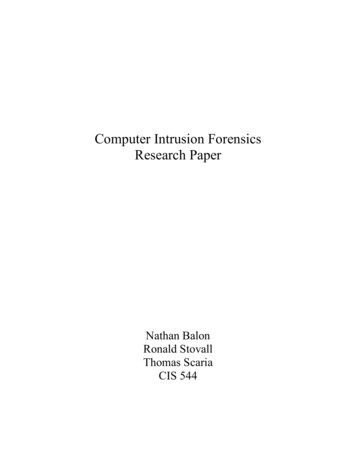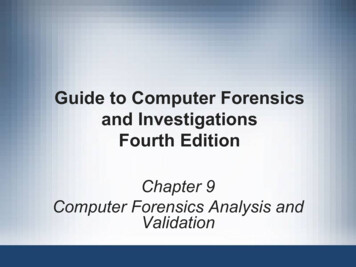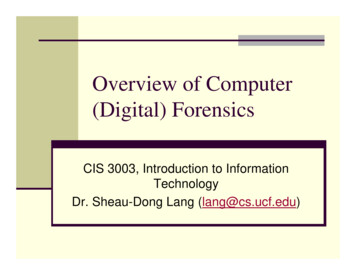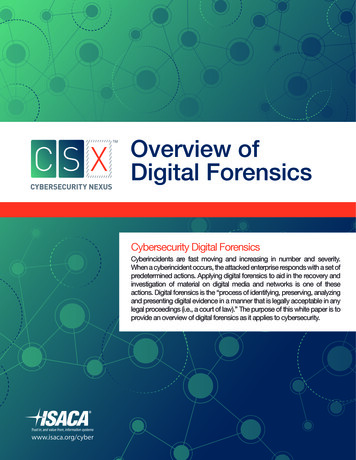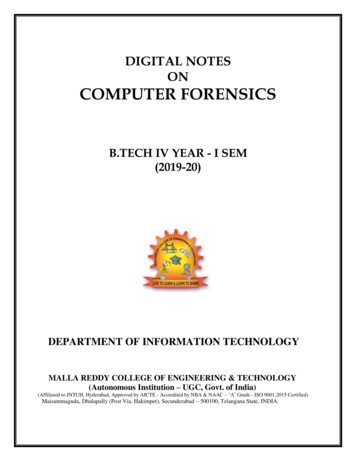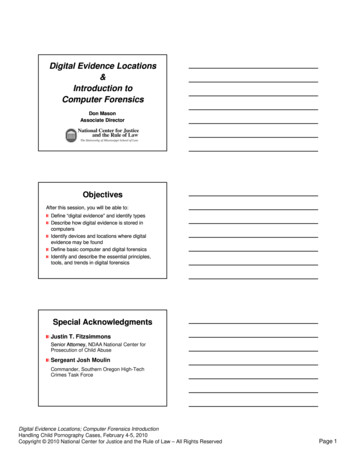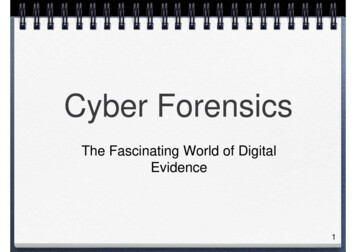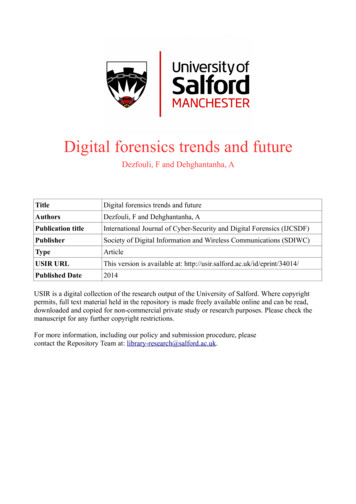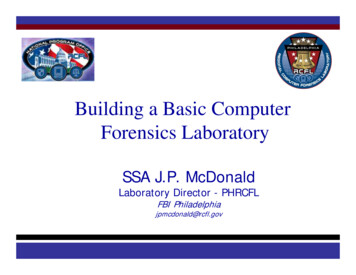
Transcription
Building a Basic ComputerForensics LaboratorySSA J.P. McDonaldLaboratory Director - PHRCFLFBI Philadelphiajpmcdonald@rcfl.gov
Topics Lab Space Equipment Needs Software Needs Supply needs Training Procedures
Lab Space Secure Adequate electricity for equipment Adequate cooling, low humidity forequipment Desks/benches for forensic analysis andadministrative work Locking rooms, or containers forevidence, both original and Derivative Internet connection
Equipment – Write Blockers Hardware writeblockers– Support all types ofhard drives– www.wiebetech.com
Equipment – Exam Computers Want fastest computers you can affordwith:– Ram – As much as it will take and you canafford– CPU – Quad, or at least duel core CPUs– Good Graphics card, Sound Card, Speakers– Fire wire 800, 400– USB 2– DVD/CD-RW and DVD/CD-R drives– Large Monitor– Printers
Exam Computers Currently evaluatingApple GS5 and AppleRaid Can Tri Boot and runApple, windows andLinux from samebox
Exam Computers - Storage 1 Terabyte drivesare here. How muchis that?– 1 million photos– 16 days of DVDquality video– 1 million minutes ofmusic
Exam Computers - Storage Need to base storage on what is being used bysubjects. With 1 TB drives now being sold, would get atleast 10 – 20 TB, or as much as you canafford. If more than 1 examiner, would recommendbuying some type of network storage (NAS,SAN) note, could also use hard drives– Possible vendors (many others are out there) Apple xraid Raid Inc. falcon Compellent SAN
Network Equipment Network switch,cabling, networkcards for forensicwork Another complete setfor Internet and afirewall, can becombinedfirewall/router/switch
Equipment – Cell Phones/PDAs Each phone and PDA usedifferent data connectorsand power connectors. May consider itips forpower needs. Sustain cables for phonedata cables. Also will need some typeof signal blockingenclosure for cell phoneexams, Faraday Bag.
Equipment – Tape Dives Tapes come in all typesand sizes– DLT/SDLT– DDS/DAT– LTO Used for readingsubject’s tapes andarchiving work product
Forensic Software Virus protection– Symantec– McAfee Forensic Suites– Encase– FTK FTK PRTK Registry Viewer– Ilook– Black Bag – Apple Cell Phones–––––Data pilotMobil edit – forensicSimmusbkforensicsSoftware from phone manufacturer System Ghosting software– Symantec – Ghost Free Forensic tools www.acesle.org
Supplies Administrative – paper, pens ect. Forensic–––––––––Cables for devicesCD-Rs, DVD-Rs, and clamshells for themTapesHard DrivesTool KitFlash lightPlastic static bags and bubble wrapLabels – CD/DVD and regularPrinters cartridges
Training - Minimum Computer hardware / Networking– A ; Net Basic Computer forensics knowledge– International Association of Computer Investigative Specialists(IACIS)– NW3C – BDRA, ADRA (Basic/Advanced Data Recovery) Tool Specific Training– Encase– FTK– Ilook Legal training – Search Warrants, testifying, computer crimelaws and issues for your country. NOTES:– The field of computer forensics requires daily learning, technologychanges everyday– Testing – Each Examiner should take and pass a competency test,to show they understand both forensic principals as well as tooluse.
Laboratory Policies A Laboratory should establish and then follow a set ofpolicies and procedures to run the lab and for doingexams in general. Basics– Chain of custody and protection of evidence Original Evidence Derivative Evidence All evidence handled by examiner should be initialed, datedand case number written with indelible marker on the item Chain of Custody (Who, What, When, Where, Why)– Examination Notes– Examination Reports– Review of work done in Lab Technical review of examiner’s notes Administrative review of Examination Report
Laboratory Guidance Scientific Working Groupon Digital Evidence(SWGDE)http://ncfs.org/swgde American Society of CrimeLaboratory Directors /Laboratory AccreditationBoard – Internationalhttp://www.ascld-lab.org/
Laboratory Procedures -Exams Exams should not be done on original evidence, a writeblocker should be attached to the hard drive and averified (MD5; SHA1) image made (DD, E01, ect.) witharchiving software (Encase, FTK imager, DD, ect ) The examination computer used for the exam should bereloaded (Symantec Ghost) between exams with a baseload and up to date virus software (Symantec, McAfee) Findings (files of interest) should be burned to CD-R, orDVD-R, and finalized (nothing else can be burned todisk) After exam, image file used for the exam should revalidated to show exam did not corrupt All of the examiner’s actions should be in their notes.The notes should be initialed on each page, pagesnumbered 1 of , and have case #.
QuestionsSSA J.P. org
– The field of computer forensics requires daily learning, technology changes everyday – Testing – Each Examiner should take and pass a competency test, to show they
